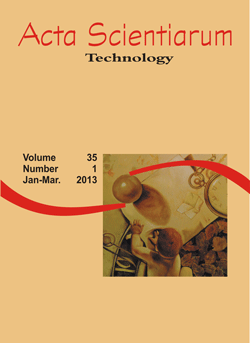<b>Treatment of textile effluent containing indigo blue dye by a UASB reactor coupled with pottery clay adsorption</b> - doi: 10.4025/actascitechnol.v35i1.13091
DOI:
https://doi.org/10.4025/actascitechnol.v35i1.13091Palavras-chave:
UASB reactor, adsorption, Indigo Blue dye, pottery clayResumo
This study aimed to evaluate the treatment of a synthetic textile wastewater containing the blue indigo dye in a UASB (upflow anaerobic reactor), on a bench scale, followed by pottery clay adsorption. The system monitoring was verified by the following physical and chemical parameters: pH, alkalinity, volatile acids, COD and removal of color. The adsorption tests using pottery clay (construction debris) as an alternative adsorbent material were performed on a jar test equipment. The results showed satisfactory effectiveness in removing color and organic matter (COD) by the UASB, at the order of 69 and 81.2%, respectively. The color removal using ceramic clay as an alternative adsorbent material was 97% for the concentration of 200 g L-1 of adsorbent, evidencing that the use of pottery clay as adsorbent material had significant and promising results, and may be used as a post-treatment unit for removal of dyes present in textile effluents, and since construction debris currently represents a major environmental problem, its use in wastewater treatment may become an alternative to a proper destination of this waste.
Â
Downloads
Downloads
Publicado
Como Citar
Edição
Seção
Licença
DECLARAÇíO DE ORIGINALIDADE E DIREITOS AUTORAIS
Declaro que o presente artigo é original, não tendo sido submetido í publicação em qualquer outro periódico nacional ou internacional, quer seja em parte ou em sua totalidade.
Os direitos autorais pertencem exclusivamente aos autores. Os direitos de licenciamento utilizados pelo periódico é a licença Creative Commons Attribution 4.0 (CC BY 4.0): são permitidos o compartilhamento (cópia e distribuição do material em qualqer meio ou formato) e adaptação (remix, transformação e criação de material a partir do conteúdo assim licenciado para quaisquer fins, inclusive comerciais.
Recomenda-se a leitura desse link para maiores informações sobre o tema: fornecimento de créditos e referências de forma correta, entre outros detalhes cruciais para uso adequado do material licenciado.



















